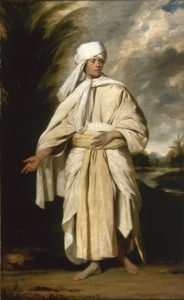Sir Joshua Reynolds is one of the most famous British portraitists of the eighteenth century. He captured the likenesses of military officers, barons, earls, dukes, and many more on his canvases, which earned him a position as president of the Royal Academy of Arts and Principal Painter to King George III. And now, the British government is emphasizing Reynolds’s cultural importance because one of his most well-known works is at risk of leaving Britain forever.
Portrait of Omai has spent most of its life at Castle Howard in Yorkshire. The subject, Omai, was the first Polynesian person to visit Britain after arriving with Captain James Cook in 1774 and soon became a sensation in London. He met with members of the Royal Society, as well as Samuel Johnson, Lord Sandwich, and King George III. During his second year in Britain, Sir Joshua Reynolds decided to paint Omai’s portrait independently, without any commission. Typical of the Grand Manner portraiture Reynolds preferred, Omai stands resplendent in white robes and a turban, posing in a style similar to the famous Apollo Belvedere statue now in the Vatican Museums.
The portrait was last sold at Sotheby’s London in 2001 for a hammer price of £9.3 million (or $13.1 million), making it the second most-valuable painting by a British artist at the time. The British government now claims the work is worth around £50 million (or $60.8 million), and has been looking for a buyer for the past year to put up the money necessary to keep the painting in the country. Boris Johnson’s government first hit the painting with an export bar in March 2022 that expired in July but was extended to run through March 10, 2023. London’s National Portrait Gallery reportedly raised £25 million by early December 2022, only half the amount necessary. The NPG hoped to acquire the work and have it ready for its reopening after a three-year closure due to the pandemic and extensive renovations.
Christopher Baker, director of European and Scottish Art and Portraiture at the National Galleries of Scotland, commented that having the painting remain in Britain “would have profound benefits and allow the numerous and riveting historical and artistic narratives it embodies to be fully developed and shared.” As hopeful as Baker is, using an export bar has a surprisingly low success rate. Though the export bar is a useful tool many governments use to keep national treasures in the country, export bars in Britain are only used successfully once in every three times. Furthermore, the export bar is most useful when there is widespread public support to have the work remain in the country, which was, unfortunately, lacking in Britain. Lucy Ward of The Guardian wrote, “Omai may yet vanish, partly because no one stood up early enough and fought for it.” Now that the export bar has expired, the British government cannot do much else to keep Omai in the country, and Britain may have to be forced to say goodbye forever.

